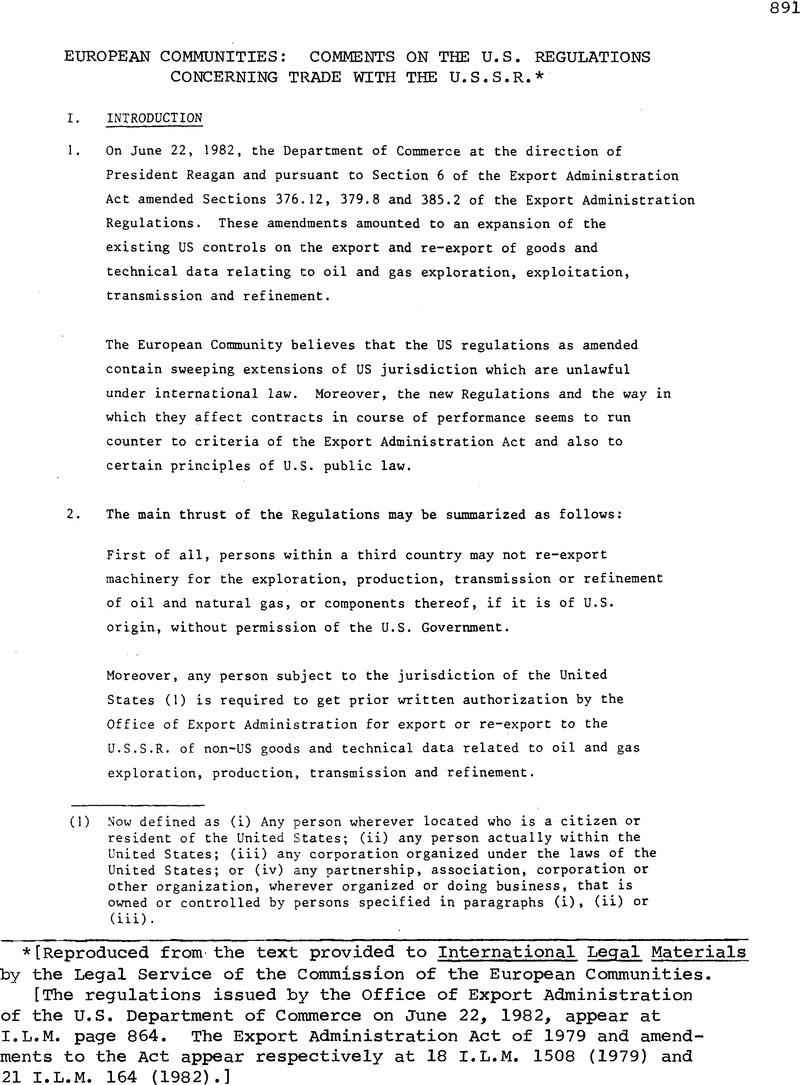Article contents
European Communities: Comments on the U.S. Regulations Concerning Trade with the U.S.S.R.*
Published online by Cambridge University Press: 18 May 2017
Abstract

- Type
- Other Documents
- Information
- Copyright
- Copyright © American Society of International Law 1982
Footnotes
[Reproduced from the text provided to International Legal Materials by the Legal Service of the Commission of the European Communities.]
[The regulations issued by the Office of Export Administration of the U.S. Department of Commerce on June 22, 1982, appear at I.L.M. page 864. The Export Administration Act of 1979 and amendments to the Act appear respectively at 18 I.L.M. 1508 (1979) and 21 I.L.M. 164 (1982).]
References
(1) This expression is very broadly defined in 15 CFR para. 379.1.
(2) Now defined as (i) Any person wherever located who is a citizen or resident of the United States; (ii) any person actually within the United States; (iii) any corporation organized under the laws of the United States or of any State, Territory, Possession or District of the United States; or (iv) any partnership, association, corporation or otherorganization, wherever organized or doing business, that is owned or controlled by persons specified in paragraphs (i), (ii) or(iii).
(1) See Restatement (2nd) of the Foreign Relations Law of the U.S. (1972), paras. 17 and 30 respectively.
(1) ICJ Reports 1970, 3, at 43.
(2) American President Lines v. China Mutual Trading Co., 1953 A.M.C. 1510, 1526 (Hong Kong Sup. Ct.) and Moens v. Ahlers North German Lloyd, 30 R.W. 360 (Tribunal of Commerce Antwerp (1966)).
(1) The application of the nationality principle would imply ipso facto some overlapping with the application of the territoriality principle and this is acceptable under international law, in some instances, but we are not in such a situation in this case.
(1) Cf. Section 8 of the Export Administration Act and below under II.A.
(1) Wisconsin v. Pelican Insurance Company, 127 US. 265, 290 (1888);Restatement (2nd) Conflict of Laws para. 89.
(2) Restatement (2nd) Conflict of Laws pp. 90.
(1) Timberlane Lumber Co. v. Bank of America, 1977-1 Trade Cases No. 61.233.
(1) Mannington Mills Inc. v. Congoleum Corp. 1979-1 Trade Cases No.62.547.
(1) Cited in Harold G. MAIER, Extraterritorial Jurisdiction at a Crossroads:
an Intersection between Public and Private International Law, 76 American Journal of International Law 1982, 280, at 300-301.
(1) Most recently in Goldblatt v. Town of Hempstead, 369 US 590, 594(1962).
(2) Nashville C. and St. L. Ry v. Walters, 294 US 405, 429 (1935).
(3) Buttfield v. Stranahan, 192 US 470, 493 (1904) indicates that insofar as it concerns U.S. external trade it may be difficult to assert Fifth Amendment rights.
(4) This is not to say that the E.C. agrees in principle to the way in which these Regulations handle the problem of extra-territoriality.
- 2
- Cited by




